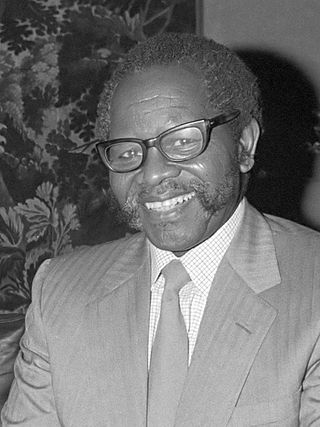
uMkhonto we Sizwe was the paramilitary wing of the African National Congress (ANC), and was founded by Nelson Mandela in the wake of the Sharpeville massacre. Its mission was to fight against the South African government.

Oliver Reginald Kaizana Tambo was a South African anti-apartheid politician and activist who served as President of the African National Congress (ANC) from 1967 to 1991.
The following lists events that happened during 1989 in South Africa.
The following lists events that happened during 1984 in South Africa.
The following lists events that happened during 1983 in South Africa.
The following lists events that happened during 1988 in South Africa.
The following lists events that happened during 1979 in South Africa.
The following lists events that happened during 1980 in South Africa.
The following lists events that happened during 1981 in South Africa.
The following lists events that happened during 1982 in South Africa.
The following lists events that happened during 1985 in South Africa.
The following lists events that happened during 1986 in South Africa.
The following lists events that happened during 1987 in South Africa.
The Church Street bombing was a car bomb attack on 20 May 1983 in the South African capital Pretoria by uMkhonto we Sizwe (MK), the paramilitary wing of the African National Congress. The bombing killed 19 people, including the two perpetrators, and wounded 217. The Church Street Bombing was the most deadly attack by the ANC.
The Gugulethu Seven was an anti-apartheid group of men between the ages of 16 and 23 that were shot and killed on 3 March 1986 by members of the South African Police force. The seven men included Mandla Simon Mxinwa, Zanisile Zenith Mjobo, Zola Alfred Swelani, Godfrey Jabulani Miya, Christopher Piet, Themba Mlifi and Zabonke John Konile. It was later uncovered that the police operation that unearthed the Gugulethu Seven's plans had been in the works for some time.
Vernon Nkadimeng was a member of the African National Congress who was killed while in exile in Botswana by the apartheid secret police.
Looksmart Khulile Ngudle [22 May 1922–5 September 1963 (aged 41)] was a South African politician. He was a Member of the African National Congress (ANC) and South African Communist Party (SACP), an Umkhonto we Sizwe (MK) Commander and South African Congress of Trade Unions (SACTU) leader in the Western Cape. Ngudle's death is controversial, as he was the first person to die in detention during South Africa's Apartheid Era.

Andrew Sibusiso Zondo was an Umkhonto we Sizwe (MK) operative. He detonated a bomb at Sanlam Centre in Amanzimtoti on 23 December 1985, killing five people.
On 14 June 1986, the Magoo's Bar at the Parade Hotel on the beach-front area of Durban, Natal Province, South Africa was attacked with a car bomb, killing three civilians and injuring 69 others. Robert McBride, a leader in Umkhonto we Sizwe, was convicted of carrying out the attack and sentenced to death, but later reprieved and released.
Phila Portia Ndwandwe, also known as Zandile or Zandi) was a fighter of the Natal cadre of Umkhonto we Sizwe (MK) formed by Muzi Ngwenya operating from Swaziland. MK was the armed wing of the African National Congress, created by Nelson Mandela in 1961. Zandi was a mother when she was abducted by Apartheid forces and tortured. She was executed.



